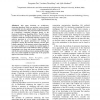Free Online Productivity Tools
i2Speak
i2Symbol
i2OCR
iTex2Img
iWeb2Print
iWeb2Shot
i2Type
iPdf2Split
iPdf2Merge
i2Bopomofo
i2Arabic
i2Style
i2Image
i2PDF
iLatex2Rtf
Sci2ools
CEC
2009
IEEE
2009
IEEE
A Bacterial Evolutionary Algorithm for automatic data clustering
This paper describes an evolutionary clustering algorithm, which can partition a given dataset automatically into the optimal number of groups through one shot of optimization. The proposed method is based on an evolutionary computing technique known as the Bacterial Evolutionary Algorithm (BEA). The BEA draws inspiration from a biological phenomenon of microbial evolution. Unlike the conventional mutation, crossover and selection operaions in a GA (Genetic Algorithm), BEA incorporates two special operations for evolving its population, namely the bacterial mutation and the gene transfer operation. In the present context, these operations have been modified so as to handle the variable lengths of the chromosomes that encode different cluster groupings. Experiments were done with several synthetic as well as real life data sets including a remote sensing satellite image data. The results estabish the superiority of the proposed approach in terms of final accuracy.
Artificial Intelligence | Bacterial Evolutionary Algorithm | BEA Draws Inspiration | CEC 2009 | Evolutionary Clustering Algorithm |
| Added | 20 May 2010 |
| Updated | 20 May 2010 |
| Type | Conference |
| Year | 2009 |
| Where | CEC |
| Authors | Swagatam Das, Archana Chowdhury, Ajith Abraham |
Comments (0)

